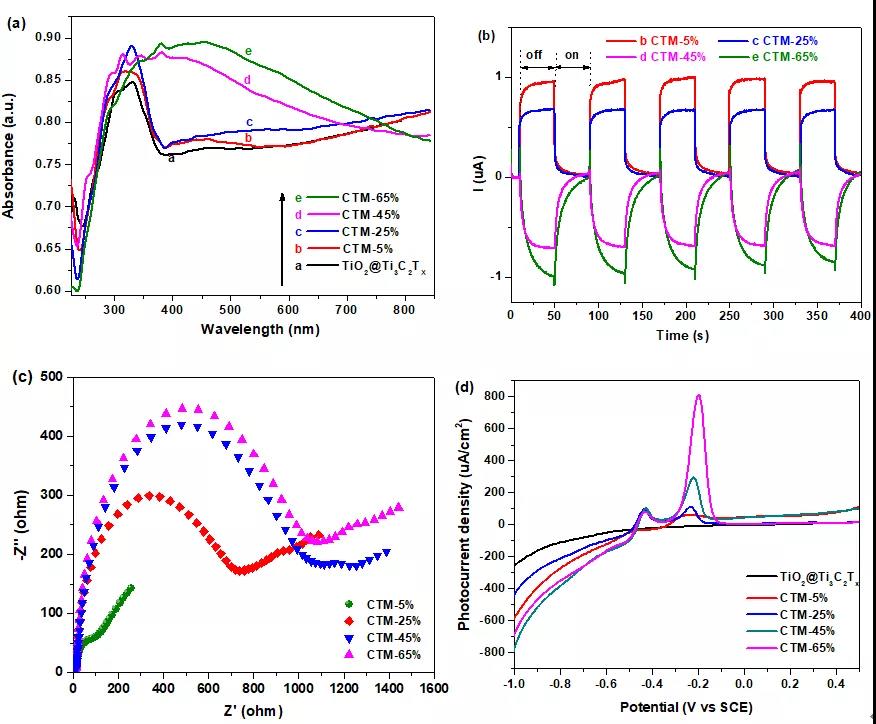Reaction pathway and activity for photocatalytic hydrogen production: Cu2O/(001)TiO2@Ti3C2Tx three-way catalyst with Ti3C2Tx as hole promoter
QQ Academic Group: 1092348845
Detailed

【Research Background】
Photocatalytic decomposition of hydrogen from water is a clean energy production technology that deals with environmental and energy crises and has broad application prospects. Since the first report by Japanese scientist Fujishima Sho, the TiO2-based semiconductor photocatalyst has been widely reported due to its excellent catalytic activity and good stability, and is considered to be one of the most promising photocatalytic materials. However, to date, photocatalytic hydrogen production is still absorbed by lower visible light, and the rapid recombination of photogenerated electron-hole pairs leads to the limitation of hydrogen production capacity and quantum efficiency, as well as the hysteretic kinetics of the HER/OER reaction on the catalyst surface. Can not be applied in practice. A large number of efforts have been made to improve the catalytic activity of TiO2-based semiconductor photocatalysts, such as Z-scheme, heterojunction, and crystal plane junctions. In addition, the cocatalyst is also critical for carrier separation and accelerated reaction. Precious metals, such as Pt, Pd, Au, Ag, etc., are deposited on TiO2 to form a Schottky barrier at the metal-TiO2 interface. . However, the use of precious metals is uneconomical, and therefore, the use of elemental Cu as a cocatalyst has been studied. However, the valence of copper is apt to change and is easily oxidized in the air, which leads to a more complicated path and mechanism of the reaction system.
【成果简介】
Recently, Professor Yu Yu from South China University of Technology and Dr. Peng Chao from Wuyi University discovered that the three-way catalyst Cu/TiO2@Ti3C2Tx system has high efficiency photolysis hydrogen production activity (Chao Peng et al. High efficiency photocatalytic hydrogen production). Over ternary Cu/TiO2@Ti3C2Tx enabled by low-work-function 2D titanium carbide, Nano Energy, 2018, 53: 97-107.), further in-depth study of the surface coverage of supported Cu2O on Cu/TiO2@Ti3C2Tx ternary The effect of the activity of the catalyst. Studies have shown that the activity, reaction path and catalytic mechanism of the catalyst are closely related to the surface coverage of the supported Cu2O species.
When the loading of Cu2O is low, the surface coverage is also small. The Cu2O nanoparticles are uniformly dispersed on the support, and (001)TiO2 is the main catalyst for the catalytic reaction. At this time, the catalytic reaction path follows the tunneling reduction mechanism: TiO2 is excited to generate electron-hole pairs, and the photogenerated holes are trapped by two-dimensional Ti3C2Tx (T is mainly -OH) with a lower work function, and electrons are aggregated on the TiO2 conduction band. Tunneling onto the Cu2O conduction band reduces Cu2O to elemental Cu. Under this mechanism, elemental Cu and two-dimensional Ti3C2Tx become electron acceptors and hole acceptors, respectively, to achieve space separation of electron-hole pairs, and to produce hydrogen reactions on Cu nanoparticles. Under the leadership of this reaction mechanism, hydrogen production activity is also relatively high.
When the loading of Cu2O is high, the surface coverage is high. At this time, Cu2O forms a dense coating on the TiO2@Ti3C2Tx carrier with small particles of 5-10 nm. On the one hand, due to the large loading of Cu2O, there are many contact sites between TiO2 and Cu2O, and electrons are difficult to accumulate on the conduction band of TiO2. On the other hand, Cu2O forms tens of nanometers thick on the entire carrier. It is also difficult for electron tunneling to occur in the cladding layer. At this time, photocatalytic hydrogen production mainly follows the traditional p-n junction mechanism. Under the lead of the catalytic mechanism, the photocatalyst‘s hydrogen production activity is rather low.
The results were published online in the international journal of International Journal of Hydrogen Energy entitled: Manipulating Photocatalytic Pathway and Activity of Ternary Cu2O/(001) TiO2@Ti3C2Tx Catalysts for H2 Evolution: Effect of Surface Coverage.
[Graphic introduction]

Figure 1. Schematic diagram of TiO2@Ti3C2Tx support and ternary Cu2O/(001) TiO2@Ti3C2Tx (referred to as CTM) catalyst with different surface coverage. (a, b) TiO2@Ti3C2Tx; (c) CTM-5%; (d) CTM-25%, (e) CTM-45%, and (f) CTM-65%.

Figure 2. Catalyst (a, b) CTM-5%; (c, d, e) CTM-25%; (f, g) CTM-45%; and (h, i) CTM-65% TEM Characterization .
 Figure 3. (a) Solid UV diffuse reflectance curve for the catalyst; (b) Transient photocurrent curve; (c) AC impedance curve; and (d) Linear scan curve.
Figure 3. (a) Solid UV diffuse reflectance curve for the catalyst; (b) Transient photocurrent curve; (c) AC impedance curve; and (d) Linear scan curve.

Figure 4. (a) photolysis of aqueous hydrogen production and (b) hydrogen production activity of different catalysts. (c) Schematic diagram of hydrogen cycle stability of CTM-5% catalyst.

Figure 5. Schematic diagram of the catalytic reaction mechanism and interface charge transfer of a ternary Cu2O/(001)TiO2@Ti3C2Tx catalyst with (a) lower Cu2O coverage and (b) higher Cu2O coverage.
[Summary of this article]
In this study, ternary Cu2O/(001)TiO2@Ti3C2Tx photocatalysts with different coverage were prepared, and the activities and reaction paths of different catalysts were investigated. Thanks to the anisotropy of Ti3C2Tx material and excellent electrical conductivity, and when T is mainly -OH, Ti3C2Tx material has a lower work function and can be used as an excellent hole promoter. The results show that the reaction path and activity of Cu2O/(001)TiO2@Ti3C2Tx photocatalyst can be controlled by adjusting the surface coverage of Cu2O. This will provide a reference for further understanding of the physicochemical properties of MXene materials, and will also provide an important theoretical basis for the design and preparation of MXene-based photocatalysts.
Literature link:
https://doi.org/10.1016/j.ijhydene.2019.09.190
Source: WeChat public number MXene Frontier
- Previous: High performance MQW p
- Next: 1


 About us
About us
